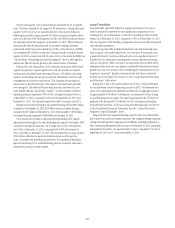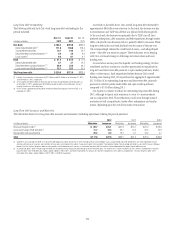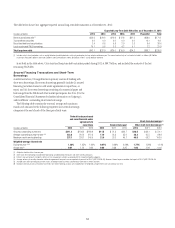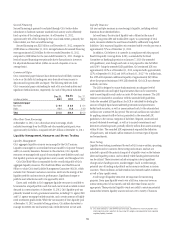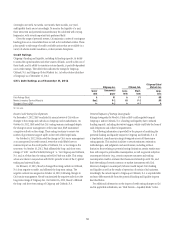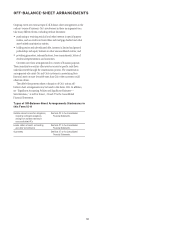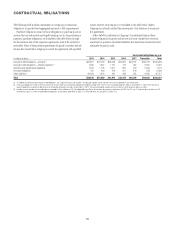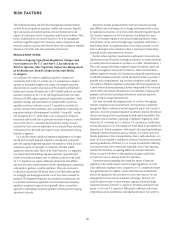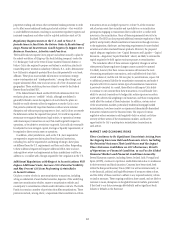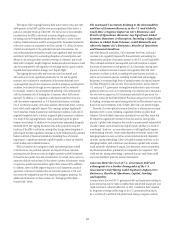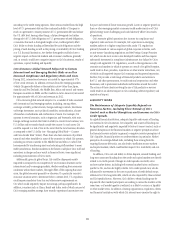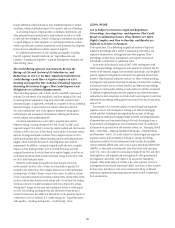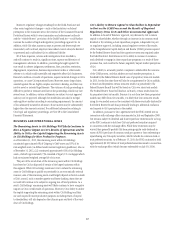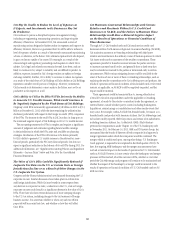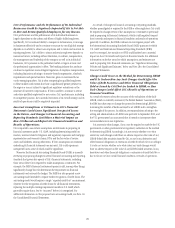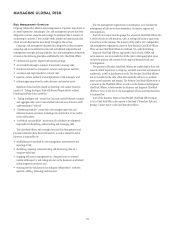Citibank 2012 Annual Report Download - page 84
Download and view the complete annual report
Please find page 84 of the 2012 Citibank annual report below. You can navigate through the pages in the report by either clicking on the pages listed below, or by using the keyword search tool below to find specific information within the annual report.62
such systems subject it to increased compliance risks and costs which could
negatively impact its earnings and result in regulatory or reputational
risk. Further, new derivatives-related systems and infrastructure will likely
become the basis on which institutions such as Citi compete for clients. To
the extent that Citi’s connectivity, product offerings or services for clients in
these businesses is deficient, this could further negatively impact Citi’s results
of operations
Additionally, while certain of the derivatives regulations under the
Dodd-Frank Act have been finalized, the rulemaking process is not complete,
significant interpretive issues remain to be resolved and the timing for the
effectiveness of many of these requirements is not yet clear. Depending on
how the uncertainty is resolved, certain outcomes could negatively impact
Citi’s competitive position in these businesses, both with respect to the cross-
border aspects of the U.S. rules as well as with respect to the international
coordination and timing of various non-U.S. derivatives regulatory reform
efforts. For example, in mid-2012, the European Union (EU) adopted the
European Market Infrastructure Regulation which requires, among other
things, information on all European derivative transactions be reported
to trade repositories and certain counterparties to clear “standardized”
derivatives contracts through central counterparties. Many of these non-
U.S. reforms are likely to take effect after the corresponding provisions of
the Dodd-Frank Act and, as a result, it is uncertain whether they will be
similar to those in the U.S. or will impose different, additional or even
inconsistent requirements on Citi’s derivatives activities. Complications due
to the sequencing of the effectiveness of derivatives reform, both among
different components of the Dodd-Frank Act and between the U.S. and other
jurisdictions, could result in disruptions to Citi’s operations and make it more
difficult for Citi to compete in these businesses.
The Dodd-Frank Act also contains a so-called “push-out” provision that,
to date, has generally been interpreted to prevent FDIC-insured depository
institutions from dealing in certain equity, commodity and credit-related
derivatives, although the ultimate scope of the provision is not certain. Citi
currently conducts a substantial portion of its derivatives-dealing activities
within and outside the U.S. through Citibank, N.A., its primary insured
depository institution. The costs of revising customer relationships and
modifying the organizational structure of Citi’s businesses or the subsidiaries
engaged in these businesses remain unknown and are subject to final
regulations or regulatory interpretations, as well as client expectations.
While this push-out provision is to be effective in July 2013, U.S. regulators
may grant up to an initial two-year transition period to each depository
institution. In January 2013, Citi applied for an initial two-year transition
period for Citibank, N.A. The timing of any approval of a transition period
request, or any parameters imposed on a transition period, remains
uncertain. In addition, to the extent that certain of Citi’s competitors already
conduct these derivatives activities outside of FDIC-insured depository
institutions, Citi would be disproportionately impacted by any restructuring
of its business for push-out purposes. Moreover, the extent to which Citi’s
non-U.S. operations will be impacted by the push-out provision remains
unclear, and it is possible that Citi could lose market share or profitability in
its derivatives business or client relationships in jurisdictions where foreign
bank competitors can operate without the same constraints.
It Is Uncertain What Impact the Proposed Restrictions on
Proprietary Trading Activities Under the Volcker Rule Will
Have on Citi’s Market-Making Activities and Preparing for
Compliance with the Proposed Rules Necessarily Subjects
Citi to Additional Compliance Risks and Costs.
The “Volcker Rule” provisions of the Dodd-Frank Act are intended in part
to restrict the proprietary trading activities of institutions such as Citi.
While the five regulatory agencies required to adopt rules to implement
the Volcker Rule have each proposed their rules, none of the agencies has
adopted final rules. Instead, in July 2012, the regulatory agencies instructed
applicable institutions, including Citi, to engage in “good faith efforts” to be
in compliance with the Volcker Rule by July 2014. Because the regulations
are not yet final, the degree to which Citi’s market-making activities will be
permitted to continue in their current form remains uncertain. In addition,
the proposed rules and any restrictions imposed by final regulations will
also likely affect Citi’s trading activities globally, and thus will impact it
disproportionately in comparison to foreign financial institutions that will
not be subject to the Volcker Rule with respect to all of their activities outside
of the U.S.
As a result of this continued uncertainty, preparing for compliance based
only on proposed rules necessarily requires Citi to make certain assumptions
about the applicability of the Volcker Rule to its businesses and operations.
For example, as proposed, the regulations contain exceptions for market-
making, underwriting, risk-mitigating hedging, certain transactions on
behalf of customers and activities in certain asset classes, and require that
certain of these activities be designed not to encourage or reward “proprietary
risk taking.” Because the regulations are not yet final, Citi is required to
make certain assumptions as to the degree to which Citi’s activities in these
areas will be permitted to continue. If these assumptions are not accurate,
Citi could be subject to additional compliance risks and costs and could be
required to undertake such compliance on a more compressed time frame
when regulators issue final rules. In addition, the proposed regulations would
require an extensive compliance regime for the “permitted” activities under
the Volcker Rule. Citi’s implementation of this compliance regime will be
based on its “good faith” interpretation and understanding of the proposed
regulations, and to the extent its interpretation or understanding is not
correct, Citi could be subject to additional compliance risks and costs.
Like the other areas of ongoing regulatory reform, alternative proposals
for the regulation of proprietary trading are developing in non-U.S.
jurisdictions, leading to overlapping or potentially conflicting regimes.
For example, in the U.K., the so-called “Vickers” proposal would separate
investment and commercial banking activity from retail banking and would
require ring-fencing of U.K. domestic retail banking operations coupled
with higher capital requirements for the ring-fenced assets. In the EU, the
so-called “Liikanen” proposal would require the mandatory separation of
proprietary trading and other significant trading activities into a trading
entity legally separate from the legal entity holding the banking activities of
a firm. It is likely that, given Citi’s worldwide operations, some form of the
Vickers and/or Liikanen proposals will eventually be applicable to a portion
of Citi’s operations. While the Volcker Rule and these non-U.S. proposals
are intended to address similar concerns—separating the perceived risks of


